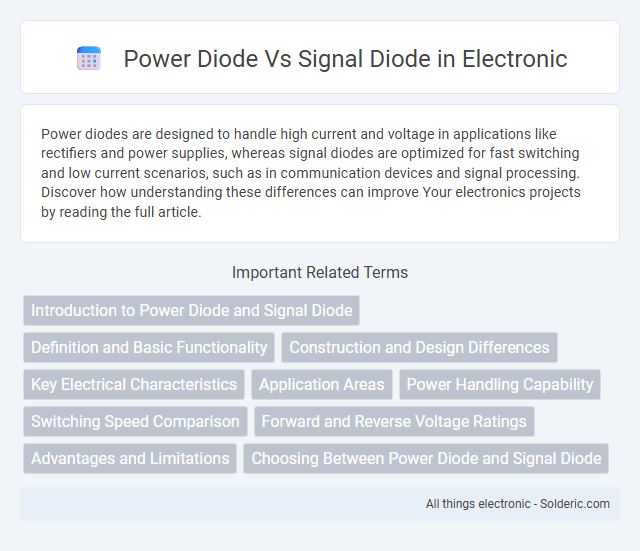Power diodes are designed to handle high current and voltage in applications like rectifiers and power supplies, whereas signal diodes are optimized for fast switching and low current scenarios, such as in communication devices and signal processing. Discover how understanding these differences can improve Your electronics projects by reading the full article.
Comparison Table
| Feature | Power Diode | Signal Diode |
|---|---|---|
| Purpose | High current rectification and power applications | Low current switching and signal processing |
| Current Rating | Up to several amperes (typically >1A) | Milliamperes range (typically <100mA) |
| Voltage Rating | High voltage tolerance (up to 1000V+) | Low voltage tolerance (typically <100V) |
| Switching Speed | Slower switching, not ideal for high-frequency | Fast switching suitable for high-frequency signals |
| Packaging | Large, robust package for heat dissipation | Small, compact package |
| Applications | Power supplies, rectifiers, motor drives | Signal demodulation, protection, logic circuits |
| Examples | 1N5408, 1N1184R | 1N4148, 1N914 |
Introduction to Power Diode and Signal Diode
Power diodes are designed to handle high voltage and current applications, typically used in power rectification and voltage regulation systems, whereas signal diodes operate at lower currents and voltages, primarily used for switching and signal processing in electronic circuits. The physical construction of power diodes includes larger junctions and heat dissipation features to manage thermal stress, unlike signal diodes which emphasize fast switching speeds and small package sizes. Understanding the distinct characteristics of power and signal diodes allows you to select the appropriate diode for your circuit's voltage, current, and switching requirements.
Definition and Basic Functionality
Power diodes are designed to handle high voltage and current in power conversion and rectification applications, whereas signal diodes manage low current signals in circuits for switching and signal processing. Power diodes feature larger junctions and robust construction for high power dissipation, while signal diodes are smaller, faster, and optimized for minimal signal distortion. Understanding these differences helps you select the right diode type for efficient circuit performance.
Construction and Design Differences
Power diodes feature a robust construction with thicker semiconductor layers and larger junction areas to handle high current and voltage levels, ensuring durability and heat dissipation. Signal diodes have a smaller, more compact design with thin semiconductor layers optimized for fast switching and low current applications. These design differences directly influence their performance, with power diodes suited for rectification in power supplies, while signal diodes excel in signal processing and high-frequency circuits.
Key Electrical Characteristics
Power diodes feature high current ratings, low forward voltage drop, and enhanced reverse recovery time for efficient power rectification in heavy-duty applications. Signal diodes are optimized for high-speed switching and low signal current with minimal capacitance, making them ideal for small-signal processing in communication circuits. The key electrical differences lie in their maximum current capacity, reverse voltage rating, and switching speeds tailored for specific operational demands.
Application Areas
Power diodes are primarily used in high-current applications such as power supplies, rectifiers, and motor drives where efficient handling of large voltages and currents is crucial. Signal diodes serve in low-current environments like signal processing, switching, and communication circuits where fast response and low forward voltage drop are essential. Understanding your specific circuit requirements will guide the choice between the robust design of power diodes and the precision of signal diodes.
Power Handling Capability
Power diodes are designed with robust semiconductor materials and larger junction areas to handle high current and voltage levels, typically ranging from several amperes to hundreds of amperes and voltages up to thousands of volts. Signal diodes, in contrast, are optimized for low current applications, generally below 100 milliamps, and lower voltage ratings, usually under 100 volts, making them unsuitable for power-intensive tasks. Your choice between a power diode and a signal diode depends on the power handling requirements of your circuit to ensure reliability and efficiency.
Switching Speed Comparison
Power diodes exhibit slower switching speeds due to higher charge storage and larger junction capacitance compared to signal diodes, which are designed for high-frequency applications with minimal reverse recovery time. Signal diodes typically switch in nanoseconds or less, making them ideal for fast digital circuits and RF applications. Power diodes, often used in rectification and power conversion, switch in microseconds due to their construction and higher current handling capabilities.
Forward and Reverse Voltage Ratings
Power diodes feature high forward voltage ratings typically between 0.7 to 1.7 volts to handle large currents and high power applications, while signal diodes operate at lower forward voltages around 0.6 to 0.7 volts optimized for small signal rectification. Reverse voltage ratings of power diodes can range from hundreds to thousands of volts to ensure durability in high-voltage environments, whereas signal diodes have much lower reverse voltage ratings, often below 100 volts, suitable for low-power circuits. The differing voltage specifications reflect the intended use of power diodes in robust power management systems and signal diodes in precise, low-current signal processing tasks.
Advantages and Limitations
Power diodes handle high voltage and current, offering robustness and low forward voltage drop, making them ideal for power rectification and high-current applications. Signal diodes excel in high-speed switching and low current operations, providing minimal capacitance and fast recovery times but are limited by low voltage and current ratings. Power diodes are bulkier and slower compared to signal diodes, which are compact and optimized for small-signal, high-frequency tasks.
Choosing Between Power Diode and Signal Diode
Choosing between a power diode and a signal diode depends on your circuit's voltage and current requirements. Power diodes handle high voltage and current loads, making them ideal for power rectification and protection in heavy-duty applications, whereas signal diodes are designed for low current, high-speed switching, and signal processing tasks. Your selection should consider the diode's maximum forward current, reverse recovery time, and the specific application's electrical demands.
Power Diode vs Signal Diode Infographic

 solderic.com
solderic.com